|
Goodbye to Wolverhampton
The Merridale Street premises were inexpensive and
primitive, and in 1958 Corfield's were advised by Wolverhampton
Council that the factory was condemned. This meant looking for a new
home, but property was extremely expensive and difficult to find, the
nearest available was at Redditch. They decided that if they moved so far, about 90% of their employees would not be able to stay, and
after polling the workforce found that just as many would move to
Northern Ireland where generous industrial development grants were
available. All assistance to find jobs was offered to the people who chose to stay in Wolverhampton. The company even put adverts in the
local newspapers, on behalf of their departing workforce, stating that
a number of highly skilled people were looking for employment. The
works closed on January 30th 1959.
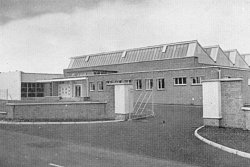 |
The new premises at Ballymoney in Northern
Ireland. |
The company moved to Ballymoney in County Antrim where
a new factory was made ready for them. Work soon got underway and
production of the Periflex 2 and Periflex 3 cameras restarted. Some
local skilled labour was available, but inevitably it fell far short
of what was required and so a lot of training was undertaken. Later
that year the Periflex 3 was given a facelift and the Periflex 3a was
launched. More modern looking knobs were used and a split-image
rangefinder was added to the focusing screen. The lens was given a
black anodised body and the adjustment rings had black and silver
finger grips.
Three new Lumar and Lumax lenses were introduced. The
first was the 85mm f1.5 Super Lumax, which had 6 fully coated elements and could focus down to 4ft. The other two were the 240mm
f4.5 Lumar and the 400mm f4.5 Tele Lumax. Within 12 months of the
move, production was higher than ever, which led to price reductions
of between 5% and 10% on cameras and lenses.
The next camera was designed as a replacement for the
Periflex 2. It was basically a cheaper version of the 3a, called the
Periflex Gold Star. The main difference was the shutter, which only
had a maximum speed of 1/300sec. At the same time the 50mm f2.4 Lumax
lens was introduced. It sold extremely well and soon became the
standard lens for the Gold Star.
The price difference between the Gold Star and the
Periflex3a was only £15 and so most people preferred to purchase the
cheaper Gold Star rather than pay the extra for higher shutter speeds.
Something had to be done about this, and so the 3a was restyled to
become the 3b. The main difference was the external metalwork which
was given a black anodised finish instead of the usual 'silver'
anodising.
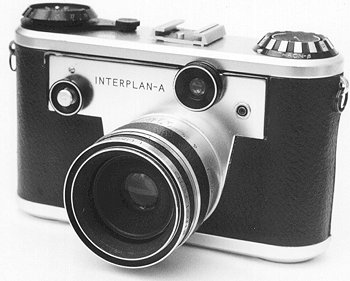 |
Another new camera was to return to the original
Periflex concept. It was to be a cheap camera that could be
used as a second body for existing camera users. It was
basically a Gold Star without the periscope viewfinder, and
was sold in three versions. The 'Interplan-A' had a Leica lens
mount, the 'Interplan-B' had a Practica lens mount, and the 'Interplan-C'
had an Exacta lens mount. |
| The Interplan-A camera with a 135mm f3.5 Tele
Lumax lens. The 135mm viewfinder objective lens is attached to
the front of the viewfinder. |
 |
The company's final 35mm camera was the Maxim, which
was a cheap camera intended to be sold in the £25 to £32 price
range. It had no periscope and a non-interchangeable 45mm f3.5 Lumax
lens. Only a few were made and it was not sold commercially.
 |
The 1960's was a time of great change and uncertainty
in the British camera market. High quality, reasonably priced Japanese
cameras were starting to appear here for the first time and so
Corfield's had to do something to counteract the threat. They decided
to develop a high quality, fairly cheap, two and a quarter inch
square, single lens reflex camera. The end product was the Corfield 66
which was designed to produce twelve pictures on a standard 120 roll
film, using a removable roll film magazine. |
| The body was constructed of aluminium pressure
die-castings and steel and brass pressings. It used a
rubberised fabric focal plane shutter with speeds from 1/10sec
to 1/500sec. Focussing was by a ground glass screen above the
instant return mirror. A focus magnifier was incorporated into
the viewing hood, the back and sides of which are made of
rubberised fabric. The
standard lens was a 4 element 95mm f3.5 Lumax which could
focus down to 4 feet. It was of excellent quality and used
Corfield's own bayonet mount. The camera sold for £76 and
initial sales were quite good. |
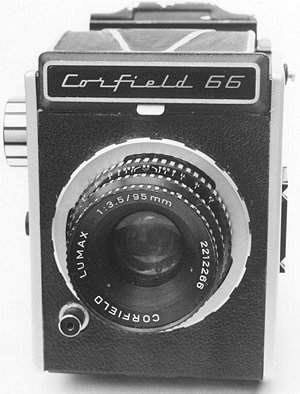 |
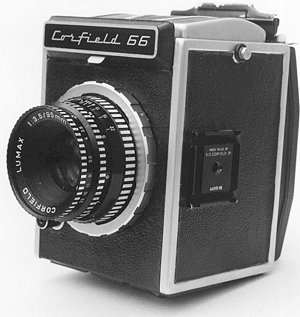 |
The camera had two sturdy tripod bushes, one on
the bottom and one on the right-hand side. |
| The camera fitted neatly in the palm of the
hand. The shutter release can be seen on the front in the
bottom left-hand corner. |
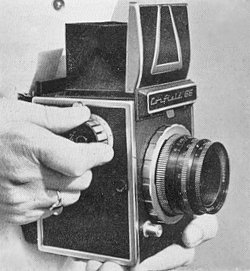 |
| The Corfield 66 showing the bayonet mount. The
large knob on the left is the shutter speed dial, the small
knob is for winding the film. The rubberised fabric
focusing hood can be seen on the top of the camera. |
 |
Sadly only one batch of this excellent camera ever
went to the dealers. The reasons are explained in the next section.
 |
|

|
|
 |
|
Back |
|
Return
to the beginning
|
|
Continue |
|





























